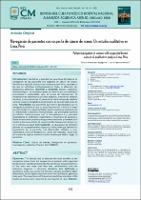| dc.contributor.author | Figueroa Montes, Luis Edgardo | |
| dc.contributor.author | Matassini Eyzaguirre, Silvana M. | |
| dc.date.accessioned | 2022-08-02T20:54:25Z | |
| dc.date.available | 2022-08-02T20:54:25Z | |
| dc.date.issued | 2021 | |
| dc.identifier.citation | Revista del Cuerpo Médico Hospital Nacional Almanzor Aguinaga Asenjo. 2021: 14 (4). | es_PE |
| dc.identifier.issn | 2225-5109 | |
| dc.identifier.uri | https://hdl.handle.net/20.500.12959/2674 | |
| dc.description.abstract | Introducción:Identificar y describir los beneficios del sistema de navegación de las pacientes con sospecha de cáncer de mama. Identificar y describir las barreras a nivel personal de las usuarias y a las que se enfrentan institucionalmente hasta la obtención del diagnóstico definitivoEstudio cualitativo . Material y Métodos:fenomenológico. Se emplearon guías de observación y se realizaron entrevistasaprofundidadparaelrecojodeinformación.Se recopilaron las experiencias de ocho personas, tres fueron personal de salud, y cinco pacientes. El personal de salud incluyo dos médicos varones y una ex navegadora en un hospital de la seguridad social de Lima. Las pacientes que fueron acompañadas por la Resultados:navegadora manifiestan que su apoyo les permitió transitar su etapa de enfermedad con mayor facilidad, tanto a nivel emocional como en lo relacionado a procesos institucionales. Las principales barreras percibidasinstitucionalessoni)infraestructurayprocesos hospitalarios ii) ineficiente seguimiento y monitoreo de pacientes. Desde el lado de la usuaria i) obligaciones familiares y domésticas ii) miedos y desconocimiento de la enfermedad iii) experiencias previas en el sistema de salud. La navegación de pacientes Conclusiones:permite un acompañamiento logístico y emocional que favorece la experienciadelapaciente.Lasdificultadeshalladasanivel hospitalario, lejos de desaparecer, logran ser reducidas, aligerando así el peso de algunos procesos institucionales que deben cargar las pacientes | es_PE |
| dc.description.abstract | Objetives: To identify and to describe the main benefits of the navigation system from the perspective of patients with suspected breast cancer. Identify and describe the barriers at the personal level of the users and those that they face institutionally until the definitivediagnosisisobtained.AMaterialandMethods:qualitative study was carried out between January and March 2020. Observation and in-depth interviews were the information gathering tools used. The experiences of five patients and three members of the health personnel were collected in one hospital of Lima. Results: The patients who were accompanied by the navigators state that their support allowed them to go through their stage of illness with greater ease, both emotionally and bureaucratically. The main perceived institutional barriers are i) infrastructure and hospital processes ii) inefficient follow-up and monitoring of patients. From the user side i) family and domestic obligations ii) fears and ignorance of the disease iii) previous experiences in the health system. Conclusions:Patient navigation allows logistical and emotional support that favours the experience of the patient. The difficulties encountered at the hospital level, far from disappearing, manage to be reduced, thus lightening the bureaucratic burden that patients must carry. There is an emotional bond between the patients and the navigators. The level of these affective relationships is mainly related to the reality of the patient, specifically to her social support network. | es_PE |
| dc.format | application/pdf | es_PE |
| dc.language.iso | spa | es_PE |
| dc.publisher | Seguro Social de Salud (EsSalud) | es_PE |
| dc.relation.uri | https://cmhnaaa.org.pe/ojs/index.php/rcmhnaaa/article/view/1320/528 | es_PE |
| dc.rights | info:eu-repo/semantics/openAccess | es_PE |
| dc.rights.uri | https://creativecommons.org/licenses/by-nc-sa/4.0/ | es_PE |
| dc.subject | Cáncer de mamas | es_PE |
| dc.subject | Navegación de pacientes | es_PE |
| dc.subject | Investigación cualitativa | es_PE |
| dc.subject | Breast cancer | es_PE |
| dc.subject | Patient navigator | es_PE |
| dc.subject | Qualitative research | es_PE |
| dc.title | Navegación de pacientes con sospecha de cáncer de mama: Un estudio cualitativo en Lima, Perú | es_PE |
| dc.title.alternative | Patient navigation in women with suspected breast cancer: A qualitative study in Lima, Peru | es_PE |
| dc.type | info:eu-repo/semantics/article | es_PE |
| dc.subject.ocde | https://purl.org/pe-repo/ocde/ford#3.02.21 | es_PE |
| dc.identifier.doi | https://doi.org/10.35434/rcmhnaaa.2021.144.1320 | |






